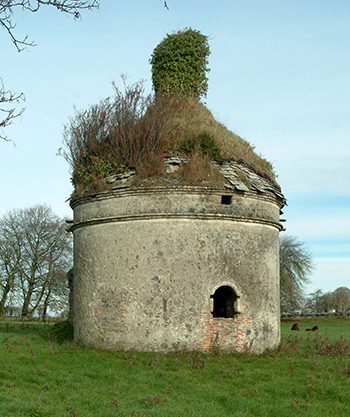Smokehouse at Frenchpark, Co. Roscommon
Published in Gems of Architecture, Issue 4 (July/August 2021), Volume 29By Damian Murphy

Above: The Frenchpark smokehouse, believed to be the only one in Ireland; it also incorporates a dovecote. (Roslyn Byrne/NIAH)
The neo-Palladian Frenchpark, Co. Roscommon, was built c. 1730 for John French (d. 1734) or his son Arthur (d. 1761), its design attributable to Richard Castle (d. 1751), although a lunette on its pedimented red-brick façade recorded a pedigree dating back to 1667, when the estate was inherited by Dominick French (d. 1670). Frenchpark prospered for a century before famine, tenant unrest and the selling of large tracts of land resulted in a much-reduced estate no longer able to support itself financially. The last owner contemplated demolition in the early 1950s but Frenchpark languished for two more decades before bulldozers arrived to clear the site.
The clearing was comprehensive. Only a handful of architectural gems were spared but they reveal the French family to have taken a belt-and-braces approach to food preservation, as in addition to an icehouse, a relatively common feature of Irish estates, Frenchpark boasts a smokehouse, believed to be the only building of its type in Ireland.
The squat, ink-bottle-like smokehouse stands two storeys high. A fireproof vaulted chamber on the ground floor, its brick-lined interior still stained with soot, was where cured fish, fowl and game were gently smoked to preserve the meat. The central chimney, a slender circular column, rises up through the second floor to emerge proud over the roof like a cork stopper.
Today the smokehouse is almost a perfect cylinder but the crumbling walls of a gabled annexe originally made up a keyhole-shaped footprint. The annexe gave access to the upper chamber, similarly brick-lined, where pigeon-holes show that the building once served as a dovecote, a structure to which it bears a strong resemblance. Whether the tower was purpose-built with a dual function in mind, a dovecote retro-fitted as a smokehouse or a smokehouse reworked as a dovecote is still the subject of debate.
Old maps and photographs suggest that the smokehouse was originally partly screened by trees, only glimpses of it visible from the avenue that ran past the front of the house to the stable yard and walled garden, but much consideration was nevertheless given to architectural ‘effect’. A failing surface finish reveals that the central door was originally flanked by at least two more openings whose arched heads gave the appearance of a simple arcade. Two bands of corbelled brickwork overhead form a collar punctuated by ledged square-shaped apertures. The conical roof over the stout drum is given a rustic finish of rough cut sandstone tiles.
The Frenchpark estate had a bountiful supply of home produce to preserve, as there was a small fishpond, a pheasantry, a deerpark and herds grazing in nearby fields. Extensive woodlands provided fuel for the fire, with the seasoned hardwood, traditionally beech, imparting distinctive flavours to the smoked meats. All of these were destroyed in the clearing of the estate, a significant loss to Ireland’s rich heritage of designed landscapes, and the survival of the remarkable smokehouse is itself truly remarkable.
Damian Murphy is Architectural Heritage Officer, National Inventory of Architectural Heritage. Series based on the NIAH’s ‘building of the month’ www.buildingsofireland.com.
















